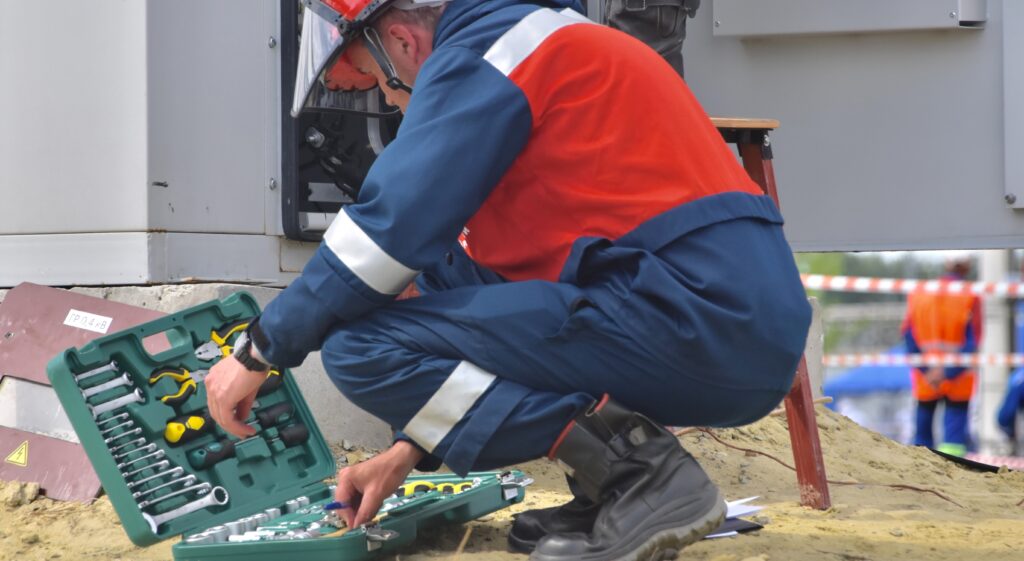Planned and reactive maintenance are both, well, maintenance, so how are they different? They both ultimately ensure functional equipment in the workplace, which then allows for enhanced productivity. You know that maintenance is associated with additional time and costs, and so you may think it’s best to avoid it. While it’s certainly better to avoid one form of maintenance, the other form actually assists to prevent it.
This blog discusses the differences between planned and reactive maintenance for your business. For personalised information, contact our team at First Class Facilities Management today.

What is Planned Maintenance?
Planned maintenance is proactive. It’s maintenance that is scheduled for regular intervals to ensure everything is working correctly, allowing for optimal efficiency. This regular maintenance identifies potential issues before they become bigger problems, which will save you more money in the long term.
An Example of Planned Maintenance
An example of planned maintenance is having your car serviced. Having your car serviced by a professional every six months or every year helps you to keep on top of any problems before they get worse. You may not even realise your car has a problem until its scheduled service, where your mechanic discovers a part that isn’t performing well and is likely to break down before the next scheduled service. Luckily, because you planned maintenance, this can be fixed before it can cause any incidents.
Yes, it will cost more money than if your mechanic said there was nothing wrong with your car but think of the bigger picture. In the long run it’s a lot cheaper to proactively fix something than it is to wait for it to fail.
Facilities Management Planned Maintenance
Facilities management for properties and buildings, including businesses, ensures essential services are maintained regularly to prevent unexpected outages or disruptions. With planned maintenance you can schedule downtime for overnights when nobody is in the office, or for quiet times during the day. Planned maintenance for buildings and offices can include:
Proper Installation: Reducing the risk of finding problems during scheduled maintenance in the first place
Cleaning: Ensuring dust and grime doesn’t build up and cause undue wear and tear
Parts Replacement: So that any under-efficient parts are replaced with ones that are fully functioning, reducing unexpected downtime
Building services involved in planned maintenance can include:
- Boilers
- Air conditioning systems
- Alarms and CCTV systems
- Water and taps
- Fire bell tests, fire extinguisher checks, and fire evacuation procedure plans
- Lamps and emergency lighting services
- Electrical testing, including portable appliance testing
- Health and safety
What is Reactive Maintenance?
Reactive maintenance is planned maintenance’s cousin. It’s enacted when the problem rears its head, and you need to act quickly to prevent any further damage to the equipment or to your bottom line. By employing planned maintenance ahead of time, you can lessen your chances of needing reactive maintenance in the first place, but reactive maintenance is always going to pop up every now and then.
Despite your best efforts, random failures and unexpected issues can crop up and need to be taken care of as soon as possible. That’s where reactive maintenance comes in. Reactive maintenance essentially offers a safety net for if something ever goes wrong, giving you peace of mind.
An Example of Reactive Maintenance
An example of reactive maintenance is when your car does encounter that issue your mechanic tried to prevent, and the part needs to be fixed or replaced. You need your car to get to work every day, so time is of the essence here. Downtime equals a loss of income— if you can’t get your car fixed quickly, you could be late into the office and risk a lower pay for that pay period, and nobody needs that.
Reactive maintenance is generally more expensive than if you had planned maintenance, as urgent repairs often come at a premium price. While this can be frustrating, technology isn’t always 100%, equipment can fail, and accidents do happen. Reactive maintenance helps to get operations back up and running as quickly as possible.
Facilities Management Reactive Maintenance
Facilities management for office buildings can include urgent repairs for general office maintenance as well as equipment. It certainly does involve processes like restoring power after an outage, but also cleaning up after any messes. Reactive maintenance measures can include:
- Carpentry
- Decorating
- Electrics
- Security
- Plumbing
- General property maintenance
Looking to Hire a Facilities Management Company?
If you’ve ever wondered what the difference is between planned and reactive maintenance, we hope this article has helped to untangle the two. While it’s always a great idea to have planned maintenance scheduled regularly to keep on top of any issues, reactive maintenance sometimes just can’t be avoided.
At First Class Facilities Management we have been offering our services all throughout London since 2010. Our team of industry professionals works hard to ensure every part of your business flows smoothly, reducing potential problems and maximising your productivity. To get started on your planned maintenance plan or to enquire about reactive maintenance, contact our friendly and helpful team today!